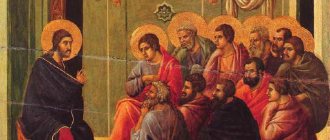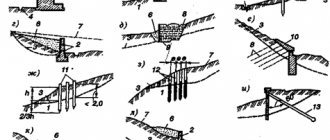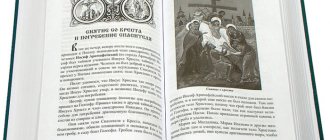The Bible, as we people of European culture perceive it, is a collection of sacred texts accepted in the Christian faith. Most of these texts - the Old Testament - tell about the times from the creation of the world until the last centuries before the Nativity of Christ. The New Testament, the second part, tells about the life of Christ, the clothes of his disciples and contains prophecies about the end of the world.
Old Testament
The word “bible” itself appeared in the 6th century. n. e. Translated from Greek, “bible” means “books.” The Old Testament (“old” is a Slavic word, in this case meaning “old”) - contains texts written in Hebrew, Aramaic (Aramaic is a Semitic language close to Hebrew) and Greek. Greek spread to the Middle East after the conquests of Alexander the Great.
There has been debate among Christians about whether Greek texts should be included in the canon, that is, the recognized texts. As a result, some denominations have a larger canon of the Old Testament, in particular, Catholics and Orthodox Christians have a larger Old Testament than Protestants.
Covenant as a union between man and God
Throughout the history of mankind, the all-merciful Lord has tried to save us from eternal death and give us immortality, for which we were created. Man was not sinless, but Jesus Christ, the Son of God, came into the world to save us for Eternal life and take upon Himself our sins. The “old” agreement with people, the Old Testament, was not broken by the coming of Christ.
During the Sermon on the Mount, He said, “Do not think that I
have come to abolish
the Law or the Prophets.
I not come
to cancel , but
to fulfill
.” The "conditions" of the Old Covenant were fulfilled and God made a new "contract", the New Covenant, with humanity.
God has enough power to simply force us to follow orders or destroy all of humanity. But our God is a God of mercy. He negotiates with a person, seeks ways to salvation that will allow people, of their own free will, to choose eternal life with God.
New Testament
There have also been disputes regarding the New Testament in different denominations, but now in the main Christian denominations the composition of the text in the New Testament is the same. As for the Jews, for them the New Testament is not a sacred text, which means that there is no concept of the Old Testament and there is no concept of “Bible”. There is a special designation for sacred texts.
The most revered part of the Jewish canon is the Torah. In addition to the main section, there are other sections, in particular the “Prophets” section, which contains texts authored by a variety of Hebrew prophets, and a narrative about the history of the Hebrew people.
In addition to this, there is also a “Scriptures” section. It contains sayings of ancient Hebrew sages and poetry, both prayerful and lyrical. But there were also texts that were not recognized in the canon.
In a word, the Bible is not some single cohesive text, but a huge number of traditions and texts in different languages. What kind of languages are these? Variety:
- Hebrew;
- Aramaic;
- Greek;
- Latin;
- Syrian;
- Coptic and others.
The Bible is connected not only with our Western civilization, but also with Islamic civilizations.
According to marketing research, 10 percent of the world's inhabitants (that's 627 million people) regularly make purchases in online stores. In Russia alone, up to 12 million people purchase goods online every year, and this figure is growing at an astronomical speed.
Analysts calculated the average amount spent per year by a typical online shopper to be $634. By the way, the volume of wholesale trade through the Internet in 2007 reached 1.3 billion dollars. Experts believe that the online shopping market in Russia will grow.
Today, 39% of goods sold online are household appliances and electronics. This is followed by a wide margin by computer components (14%), another 10% comes from games, toys, children's products and gifts. For household goods - 8% of all purchases, the same for auto parts. 7% is occupied by books, newspapers, magazines and discs (CDs, DVDs and others). But the demand for cosmetics is growing exponentially.
How to shop online
The boom in online shopping is most likely explained by the fact that constant work with the Internet has developed a strong habit in people, which smoothly turns into an instinct: to search for any information, you need to go to the Internet. The simplest query in a search engine – for example, “mobile phone” – will return a huge number of links to sites offering this product. It should be noted that with the current level of technology, payment for purchases can be made instantly, without leaving your computer. And most importantly, you won’t have to part with your dear crisp banknotes - just one keystroke: payment is made using electronic money. (In Russia, the two most widely used electronic payment systems are “WebMoney” and “Yandex.Money”.) One cannot but agree that this psychological moment of virtual purchases often plays a cruel joke on the buyer, facilitating spontaneous, thoughtless purchases.
The range of services in online stores is almost always the same. Using a simple navigation system, moving from section to section, a product is selected. At the same time, an experienced buyer has several windows open at once with the websites of different virtual stores. Therefore, “Internet shopping sharks” take three to five hours to make a decision, especially if it concerns large acquisitions.
On well-designed web resources, you can search for a product “by manufacturer” or limit yourself to a specific model and find out its detailed characteristics. If you wish, you can discuss the advantages and disadvantages of a particular product with specialists or other clients (there is a special forum for this).
The quality of service in different e-stores varies greatly. In fashionable virtual supermarkets, all product characteristics are summarized in neatly designed tables. In simpler stores, the same data is implemented in the form of text help, and some important parameter can easily be omitted.
The level of advisory assistance to the client also differs. The most serious stores offer a whole range of services: from a regular phone call to purely online methods of communication, such as an ICQ dialogue with an on-duty consultant. Most stores are still limited to consultations by phone and email, which is less convenient. Emails can take more than a week to be processed (depending on your luck), and calling to another city is very expensive.
The product in an electronic store cannot be touched, and many people try to compensate for this disadvantage with additional services typical of the Internet. Most sites use a comparison function, using which you can compare two or more models at the same time and make the right decision.
The ordering procedure in all electronic stores follows a single scheme. Data about the model, the name of the contact person, address and telephone number are entered into a certain form. Unfortunately, in some cases, an attempt to complete a purchase can result in a long and tedious filling out of a questionnaire, where it is necessary to indicate information that is clearly required not for delivery of the goods, but for the subsequent “processing” of the client with advertising messages.
To avoid getting burned. Is it dangerous to shop online?
Firstly, the majority of the population believes that online purchases are much cheaper than regular purchases. After all, online stores do not pay for the rent of sales floors and warehouses, and do not have to maintain a large staff of employees. This is wrong. The costs of creating virtual stores can reach tens of thousands of dollars. It’s not enough to register a catchy domain name like pokupki.ru (com) and competently build a website. You will have to fork out money for expensive licensed software, enlist the support of suppliers, and, most importantly, spend money on “promotion” of the store, that is, on advertising aimed at the target audience. It is clear that these costs are reflected in the price of goods.
Studies of the Internet book market have shown that the average deviation of prices in online stores, in relation to their cost in a regular store, is 12.2%, the maximum is 23.6%, and the maximum difference between prices for the same book was as much 33.4%!
Advice one
: before placing an order for an item you like, it is better to look at the prices in an offline store.
Not everything is simple with the delivery of purchased goods, especially if the buyer lives in the periphery. You need to be prepared for the fact that delivery conditions for purchases in different stores vary greatly. Some deliver goods by mail. Moreover, in some cases, online stores do not take responsibility for possible problems associated with the work of the post office. Others have their own logistics system, but in this case the delivery time can reach several months. In some online stores, the delivery price depends on the weight of the purchased product, in others on the dimensions, in others - on the total amount of the purchase.
Tip two
: It is necessary to check the delivery conditions of the goods. The cost of delivery may be more expensive than the purchase itself, and the conditions are such that you will have to spend a lot of time waiting for the desired product.
At first glance, the range of electronic stores is much wider than regular ones. However, upon closer examination, it turns out that not all of the models presented on the site are in stock.
Tip three
: It is better to check by phone whether the product is in stock.
Of course, just like in real life, online you can easily “run into” non-virtual scammers and swindlers who want to take over your hard-earned money.
Signs of an Internet scam may include suspiciously low prices, lack of a phone number on the website, mailboxes with free content (such as mail.ru), and a requirement for 100% prepayment.
Online trade in counterfeit products has become commonplace recently. For example, a buyer can easily be “foisted” on a mobile phone model that is not certified in Russia, that does not support the accepted communication standard, or is not equipped with Russian font. There are times when goods arrive in the mail with factory defects or, for example, equipment that is clearly used. Litigation in such cases, especially if the seller is located in another city (or even country), is a rather long and tedious matter.
Experts believe that online purchases should only be made in specialized stores. That is, where they sell one type of product, for example, only household appliances, or only auto parts. This, to some extent, can protect the consumer from possible mistakes. As a rule, analytical information can be found on such Internet resources.
Science Studying the Bible
The science of biblical studies studies the Bible - it is a very complex, but at the same time, very important science. But today we will talk about the Bible in the narrow sense of the word, as a most valuable source about the history of the Middle East at the end of the second millennium BC. e., beginning of the first millennium AD. e.
At this time, in the steppe regions between Phenicia, Babylonia and Egypt, cattle breeders, including Jewish tribes, had long grazed their herds. Previously, they apparently lived in Babylonia and came to the land of Canaan, having acquired the name Jews or Ibrim, which means “Beyond the River”, who came from the other side of the Euphrates River. This name is also consistent with the biblical legend about the arrival of the ancestor of the Jewish people Abraham from across the Euphrates River.
general description
The Old Testament is the oldest part of the Christian Bible. It is also the oldest Jewish Holy Scripture (Tanakh), which has very great sacred meaning for this people. The Old Testament can be said to be the general religious rules for all Christians and Jews. They include instructive stories, myths, undeniable dogmas and a considerable part of real events, that is, history, according to which many researchers have reconstructed pictures of the past.
Pentateuch
As we already know, the Pentateuch has the greatest authority in both the Christian and Jewish canons. It is the Pentateuch that contains the texts whose authorship is attributed to Moses. However, it is not. Scientists have established that there are texts that are both more ancient and less ancient. So, we can only talk about the authorship of Moses in a figurative sense.
It is these texts that contain the story of the first people, about Adam and Eve, about their expulsion from paradise, about how Cain killed Abel, about the flood and about the Babylonian pandemonium and many many other stories.
Many of these stories have parallels in other mythologies of the Middle East, in particular the mythologies of Babylonia or Ugarit. But there are also purely Jewish stories, in particular the ancestors Abraham, or about Joseph, who saved the Jewish people by allowing them to settle in Egypt during a famine. Or about Moses, who saved the Jewish people, on the contrary, by leading them out of Egypt and freeing them from the slavery of Pharaoh.
A significant part of the Pentateuch consists of moral instructions, in particular the Ten Commandments. The texts were finally formed in the first millennium BC. e., but the folding itself took place much earlier and apparently contained texts accepted in the oral tradition.
The meaning of the covenant in different religions
In every religion this concept has its own meaning.
In Christianity
In Christianity it has the following meanings:
- Christian scripture that arose after the birth of Jesus Christ.
- A term that denotes a new qualitative relationship between God and man.
- The main commandments of Christianity.
In Judaism
In Judaism, the concept has a large number of meanings:
- One of the schools of Calvinist thought that views all history as a series of covenants between God and people.
- The Seven Commandments, which according to Judaism are necessary for humanity.
- 10 commandments of Moses.
- Circumcision is a surgical operation that removes the foreskin from boys and men, as a sacrificial offering of a part of one’s body to the Lord.
In other religions
In other religions it has several meanings:
- In the Baha'i religion, an agreement that is concluded by a believer at the moment he accepts a particular religion.
- Concepts of many authors who strive to create a modern new worldview.
- The Abrahamic contract in Mormonism is the contract of exaltation that was made between God and Abraham at the time of Abraham's celestial marriage.
Celestial marriage is a major part of preparation for eternal life. It requires entering into a marriage partnership with the right person in the right place, and faithfully keeping that sacred covenant.
There is no concept of covenant in Islam. The Koran does not say anything about the agreement that Allah would enter into with Muslims. Allah sends down to the prophets and messengers each his own text. The messenger's task is to convey a text, which, in essence, is instructions for correct behavior. This is a mandate, or even an order. Muslims did not accept either Christian or Jewish scriptures.
Books of the Prophets
The next section is “Books of the Prophets.” It contains texts from a variety of religious preachers who were active in Jewish Israel in the 8th - 6th centuries BC. e. According to the time of compilation, they are also adjacent to the so-called historical books, which tell about the wars waged by the Jewish people with neighboring peoples, about the first kings such as Saul, David and Solomon.
The last section of Scripture contains texts that are unusually varied, both in genre and in the time of their writing. Researchers from different centuries have selected Bible texts and interpreted them, and that is why the rich material that the Bible contains, material on the history of the Middle East, should be taken with caution.
The Original Form and Language of the Holy Scriptures
The Old Testament books were originally written in Hebrew. Later books from the time of the Babylonian captivity already have many Assyrian and Babylonian words and figures of speech. And the books written during Greek rule (non-canonical books) are written in Greek, the Third Book of Ezra is in Latin. The books of the Holy Scriptures came out of the hands of the holy writers in appearance not the same as we see them now. Initially, they were written on parchment or papyrus (which was made from the stems of plants growing in Egypt and Palestine) with a cane (a pointed reed stick) and ink. As a matter of fact, it was not books that were written, but charters on a long parchment or papyrus scroll, which looked like a long ribbon and was wound onto a shaft. Usually scrolls were written on one side. Subsequently, parchment or papyrus tapes, instead of being glued into scroll tapes, began to be sewn into books for ease of use. The text in the ancient scrolls was written in the same large capital letters. Each letter was written separately, but the words were not separated from one another. The whole line was like one word. The reader himself had to divide the line into words and, of course, sometimes did it incorrectly. There were also no punctuation marks or accents in the ancient manuscripts. And in the Hebrew language, vowels were also not written - only consonants.
The division of words in books was introduced in the 5th century by the deacon of the Alexandrian Church Eulalis. Thus, the Bible gradually acquired its modern form. With the modern division of the Bible into chapters and verses, reading the holy books and searching for the right passages in them has become an easy task.
Jewish canon
The most ancient and also Jewish version of the Holy Letter is called the Tanakh. It consists of three parts, which are still confessed by Jews in the ancient language. The first part is the Law or Torah. It includes the Pentateuch of Moses. She is followed by Prophets or Neviim. Here the prophets of the Old Testament wrote their expositions. It was based on their status that this section was divided into three more parts - Early Prophets, Late and Minor. It is worth noting that Neviim also has many historical chronicles that are true. The third part of the Old Testament is Scripture, or, in the native language, Ketuvim. Here are stories of Israeli sages, as well as sacred poetry from ancient times.
Interesting history of the Tablets
According to legend, the commandments of the Old Testament were given to Moses by the Lord himself on Mount Sinai. They were carved on tablets - stone tablets, which, as many claim, became the first version of the Bible. Lightning struck the stone, splitting it into two parts. On each of them ten words were carved, which became the basis of biblical laws. We briefly list them below:
- I am your Lord.
- Don't make yourself an idol.
- Don't take the name of the Lord in vain.
- Work for six days, and do nothing on the seventh.
- Honor your father and mother.
- Don't kill.
- Don't commit adultery.
- Don't steal.
- Don't lie.
- Do not covet your neighbor's house.
Let's review the Jewish prophets again
In fact, the names of those characters who composed the Holy Scriptures, which became the basis of two religions at the same time, have long been heard by every person. But in order to be more specific, we will make a list of the most “important” of them - or the early ones, and then we will look at the rest - the later and small ones. The main prophets of the Old Testament are undoubtedly Isaiah, Jeremiah, Ezekiel and Daniel. The later ones are Jonah, Joel, Hosea, Amos, Habakkuk, Zephaniah, Nahum, Micah, Haggai, Malachi, Zechariah, Obadiah. In general, the prophets in their books argued that any moral and ethnic values should always be higher than cultural ones. Most importantly, their teachings were and remain the basis of Judaism, and they also became the foundation of Christianity in all its forms.









